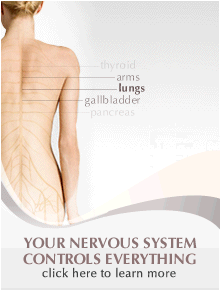Slipped Disc
A disc can’t slip. But it can wedge, bulge, protrude and herniate. Chiropractic care may help.
Space for Nerves

The most serious disc problem is a prolapsed disc in which the soft center ruptures and leaks.
The disc is a special cartilage between the bones of your spinal column. It attaches to the vertebra above and below it. This creates the separation between spinal bones so pairs of nerves can exit the spinal cord.
Turning and Bending
Each spinal disc has a jelly-like “ball bearing” core that is contained by bands of fibrous tissue. Healthy discs give you flexibility for normal turning and bending. Improper lifting, slips, falls and car accidents can cause the core to shift:
Herniation - disc wedging narrows nerve openings. Obvious symptoms may not be present.
Protrusion – like a blister, the disc bulges where it is the weakest, causing nerve pressure.
Prolapse – with the cushioning and separating compromised by rupture, movement is painful.
Chiropractic First
Like most health problems, holistic chiropractic has been a natural solution that helps people heal from a variety of disc problems.
Frequently Asked Questions:
- How does chiropractic help disc problems?
The purpose of chiropractic care is to locate and correct interference with the proper nervous system control of your body. Because the intervertebral discs are so close to the spinal cord and nerve roots, disc involvement is quite common in chiropractic cases. Chiropractic adjustments help restore the natural self-repair mechanisms that lie within each of us. If caught before permanent damage, disc tissue often returns to a more normal size and shape.
- Aren’t disc problems simply the normal aging process?
No. However, many disc problems are the result of years of neglect. Many spinal problems are nonsymptomatic until the advanced stages of degeneration. There are many cases of elderly patients who have maintained their spine throughout their lives who enjoy excellent spinal health and function.
- I didn’t do anything so how can a disc be involved?
This is a common refrain. Because our bodies are unusually adaptive, we can often accommodate a variety of stresses for years. Finally, like the “straw that broke the camel’s back,” we turn or bend funny and suddenly our spine succumbs to the accumulation of stress.
 Request Appointment
Request Appointment Email Us
Email Us Office Hours
Office Hours 


